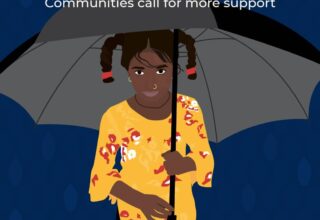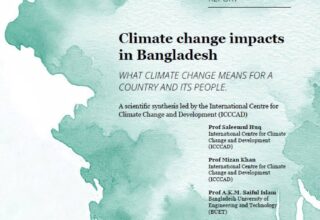The Paris Agreement emerged at the same time as the UN Sustainable Development Goals (SDGs), which also chart a future of more environmentally friendly development. What separates the Paris Agreement and SDGs from previous climate and development efforts is that they are universal and required of every signatory country. For developing nations, including the 47 least developed countries (LDCs), the Paris Agreement and SDGs represent a new approach to climate change and development. Developing countries have long argued for common but differentiated targets; and while the onus for climate change mitigation under the Paris Agreement is still on developed countries, developing countries are required to reduce emissions as much as possible in their contexts. This aligns with the framework and vision of the SDGs, which call for more environmentally and ecologically sustainable development. Thus, low-carbon resilient development (LCRD), which seeks “triple wins” by “reducing carbon emissions while simultaneously building climate resilience and supporting development” (Fisher 2013), is gaining traction in LDCs, even though collectively they account for roughly about 3–6 percent of total global greenhouse gas (GHG) emissions (Climate Analytics 2017; Bowen et al. 2011).
During the 22nd Conference of the Parties (COP22) in Marrakech in 2016, for instance, 24 LDC members of the Climate Vulnerable Forum pledged to use 100 percent renewable energy by the year 2050. In 2015, all LDCs submitted their intended nationally determined contributions (INDCs) to the UN Framework Convention on Climate Change. Of these, 38 have already been ratified. Additionally, LDCs have begun efforts to integrate LCRD into national climate change strategies much earlier (Bangladesh’s Climate Change Strategy and Action Plan 2008, Ethiopia’s Climate Resilient Green Economy Strategy 2011, etc.). Fisher (2013) also notes that by 2012 nine LDCs had developed national strategies that addressed both low-carbon development and climate resilience, and many other LDCs have followed suit (Fisher and Mohun 2015). Implementing LCRD, however, is a challenge for many developing countries, whose development plans often include extensive investment in fossil fuel infrastructure. This essay highlights the benefits of investing in LCRD from an LDC perspective, looks at the difference between the rhetoric and reality of LCRD in LDCs, and recommends that it will be more cost-effective and efficient to invest in low-carbon technologies now than to pay transition costs in the future.
Benefits of LCRD for LDCs
There are a few primary reasons why it makes sense for LDCs to adopt low-carbon development pathways.
Beyond the fact that climate change is a global problem that will hinder development everywhere, making it essential to reduce GHG emissions as much as possible, a growing number of LDCs also understand the economic opportunities in leapfrogging investments in carbon-intensive technologies traditionally considered synonymous with economic development (Bowen et al. 2011). Developed countries like Germany are facing immense costs as they attempt to transition from fossil fuels to renewable energy. LDCs could avoid these costs by investing now in low-carbon infrastructure rather than waiting until they become middle-income countries, at which point reducing GHG emissions will be more of a necessity. This requires a different framework for thinking about 2030 emissions-reduction goals: Instead of seeing these goals as final targets, LDCS should view them as steps on the way to zero net emissions. In other words, emissions should be reduced to achieve short-term targets that will contribute to long-term ones. The NDC of Bangladesh, for example, calls for reducing GHG emissions in the power, transport, and industry sectors by 12 MtCO2e by 2030, or 5 percent below business-as-usual emissions for these sectors. The country’s National Renewable Energy Policy (2008) suggests developing renewable energy resources to meet 10 percent of total power demand by 2020. The country’s Power Systems Master Plan (2016), however, projects that Bangladesh’s power demand will more than triple by 2041 (to 57,000 MW) compared to 2018 installed capacity. Under the plan, Bangladesh would generate 70 percent of its projected demand from fossil fuels, namely gas and coal, while it has set a target of generating about 6.8 percent of total demand from domestic renewable energy sources. Clearly Bangladesh plans to invest more in fossil fuel—but this would restrict the country’s ability to achieve more ambitious emissions-reduction targets beyond 2030. The policy and infrastructure required to achieve a short-term emissions-reduction target differ from the policy and infrastructure required to achieve a longer-term target. Thus, policies and national plans should be tailored to meet long-term targets, with shorter-term milestones marking a realistic pathway.
Furthermore, by focusing on low-carbon growth, LDCs will likely benefit as the cost of low-carbon technologies falls. The average electricity price across LDC capitals, at 22.4 US cents/kWh, is considerably higher than those of developed countries such as the United States (where the commercial rate was 10.08¢/kWh in 2016) (UN OHRLLS 2018). Electricity prices in LDCs range from 5.7¢/kWh (Bhutan) to 96¢/kWh (Solomon Islands), with countries highly dependent on imported fossil fuels having the highest rates (UN OHRLLS 2018). The International Renewable Energy Agency (IRENA 2018) reported that with increased deployment, the cost of electricity from renewable energy declined worldwide in 2016 and 2017, bringing prices within the range of fossil fuel–based electricity. The falling costs of renewable energy indicate that previously uneconomic power generation strategies will become profitable and bring about a paradigm shift in the competitiveness of low-carbon power (IRENA 2018).
Low-carbon options will also likely be “export friendly” for LDCs as countries in the global North will tend to promote low-carbon consumption (Bowen et al. 2011). By investing in LCRD, LDCs can achieve multiple competitive advantages, such as improved management of natural capital, enhanced competitiveness in the face of global mitigation policies, and increased market access and share through sustainable practices (Ellis et al. 2013; Bowen et al. 2011). LDCs may also be able to pioneer low-carbon research and negotiate international intellectual property agreements that would enable investment in low-carbon technologies and approaches (Bowen et al. 2011). Furthermore, the costs of reducing emissions in LDCs, particularly from agriculture, land use, and deforestation, are relatively cheaper. As Bowen et al. (2011) noted, “The rest of the world has a good reason, on efficiency grounds, to encourage LDCs to exploit these options to minimize the global costs of decarbonization.”
Additionally, LCRD brings LDCs many co-benefits. In their LDCs, more than 90 percent of LDCs (44 of 47) recognize renewable energy as a priority area and a key enabler of sustainable development. In 2016, the share of the global population without access to electricity was 55.2 percent, which overlaps with the portion living in acute poverty. Developing off-grid renewable energy sources can help LDCs improve electricity access, harness indigenous energy supplies, provide greater energy security and flexibility, reduce foreign exchange needs for fossil fuel imports, decrease environmental pollution, and improve quality of life (Asaduzzaman et al. 2013; UN OHRLLS 2018). Research in several LDCs suggests that solar-powered lighting significantly reduces energy costs, lowers CO2 emissions, provides health benefits (particularly for women and children, who tend to spend more time indoors in several LDCs) and improve children’s education, since they have more time to study at night (Asaduzzaman et al. 2013; UNCTAD 2017).
Increased use of renewable energy technologies will also diversify the power generation mix in LDCs, thereby enhancing the resilience of the power generation system. Such arguments are becoming even more compelling as the impacts of climate change increase. Zambia, for example, is considering diversifying its current power mix by using solar power following a prolonged drought that depleted the country’s main energy source, hydropower (Reuters 2018).
Lower-emission technologies in the agricultural sector could also enhance efficiency and provide environmental benefits. For example, the alternate wetting and drying method for rice production can reduce water consumption, diesel use, crop residue burning, and other associated costs. Through careful resource management and optimized productivity, sustainable agricultural practices would not only minimize emissions but could also address food security concerns in many LDCs.
LCRD technologies also can provide direct and indirect health benefits (Watts et al. 2015). For example, improved indoor air quality through clean household cooking technologies could substantially reduce the heath burden of indoor air pollution in LDCs. Accounting for the health co-benefits of low-carbon development can offset of the overall cost of decarbonization.
Between rhetoric and reality
Unfortunately, while many LDCs have voiced their support for low-carbon development, this commitment is often belied by on-the-ground reality. Bangladesh, for instance, has been hailed worldwide as a “solar nation” for its massive distribution of solar home systems among the rural poor, and yet most of its energy plans also call for heavy investments in fossil fuels, namely coal and natural gas (Power Division 2016). The Power Systems Master Plan of Tanzania has set a target of increasing installed peak capacity sevenfold, from 1,000 MW in 2013 to 7,450 MW in 2035 (Teske et al. 2017). But, as in Bangladesh, this plan would meet most of future power demand from natural gas and coal.
The first review of SDG7 (“Ensure access to affordable, reliable, and modern energy for all”), presented at the 2018 UN High-Level Political Forum, noted that despite significant progress toward sustainable energy access in many LDCs, achieving SDG7 by 2030 will be an “enormous challenge” for most LDCs (UN OHRLLS 2018). This discrepancy arises not because low-carbon development would fail to provide benefits but because multiple factors, including countries’ internal political economies, tend to deter implementation of LCRD and favor development pathways highly dependent on fossil fuels.
Ellis et al. (2013) noted a set of barriers to LCRD, including costs associated with change; vested interests opposed to change; poor understanding of potential risks, opportunities, and trade-offs; prioritizing short-term benefits over longer-term goals; and the lack of technological or institutional capacity to carry out an LCRD agenda. Lack of national leadership, poor governance, the rent-seeking behavior of governments, and highly complex or fragmented decision-making may also deter LCRD in LDCs. The technical and financial constraints evident in LDCs’ first NDCs showed that assistance will be needed to build institutional capacity and enhance country systems’ ability to formulate and implement ambitious NDCs (Climate Analytics 2017).
In addition, a recurring difficulty for LCRD is the limited engagement of relevant local stakeholders in the design and implementation of donor-driven projects (Alam et al. 2011; Ayers et al. 2011; Fisher et al. 2017), which raises questions about the ownership of local climate-resilience planning. Developing a national LCRD strategy can be perceived as an additional, unnecessary burden, especially if a range of climate change plans already exists. National stakeholders in Bangladesh tend to believe that the country’s high climate vulnerability makes adaptation a national priority, and that emissions reduction is the responsibility of developed nations. A similar view prevails in Nepal (Fisher et al. 2017).
Current evidence also shows that relationships between actors at different scales influence their preferences for advancing or delaying implementation of LCRD plans (Fisher et al. 2017). Particular interests may lead a government to favor particular energy sources and determine who wins or loses in low-carbon development. The main industries in a national economy often oppose change they consider a threat to their growth. Lobby groups and coalitions ranging from those with vested interests in highly polluting industries to groups representing the interests of the poor may resist progress toward LCRD.
Moving forward
As LDCs set out to implement LCRD policies and plans, discrepancies remain between on-the-ground reality and policy rhetoric and visions (Fisher et al. 2017; Fisher 2013). It is important for all countries to decarbonize development or transition to low-carbon economies. LDCs, for their part, must back up their rhetoric with tangible actions, recognizing that their efforts to decarbonize will not only help keep global temperature rise below 2°C but will also help them achieve the Sustainable Development Goals. This is easier said than done, as competing interests and trade-offs may arise, especially considering tight financing conditions in LDCs and priorities such as poverty alleviation and energy access. Furthermore, varying heterogeneity across countries may also make strategies or technologies that are viable in one context incompatible in others. While markets globally are increasingly favorable to low-carbon development, which LDCs can benefit from with some forward thinking, solely relying on the markets’ spontaneous response may not be sufficient to bring about the momentum needed for the low-carbon transition.
Fisher (2017), studying the political economy of LCRD in selected LDCs, suggested a range of strategies to facilitate and support implementation of LCRD plans. These include identifying and engaging a diverse range of actors to ensure widespread buy-in and ownership. In LDC contexts, actors with convening authority and influence may play an important role in driving LCRD forward and bringing diverse actors together. In Ethiopia and Rwanda, for example, political support from the highest levels propelled LCRD and attracted other high-level actors (Fisher et al. 2017). It is also important to identify the political economy of LCRD plans, strategies, and financing, which will clarify how different approaches will move forward and identify any potential obstacles to implementation. Developing policy networks of actors with common interests around LCRD may be useful in this regard, since such cooperation from multiple sectors could facilitate innovation, learning, and improvement of LCRD approaches (Fisher 2017). Having said that, to ensure long-term sustainability, LCRD plans must ensure that they are equitable, just, and acknowledge the priorities of society’s poorest members.
The international community also has an essential role to play in supporting LDCs’ transition to low-carbon economies. This may include greater provision of aid and technical assistance and the smooth transfer of appropriate clean energy technologies. Ultimately, LDCs will be required to have low-carbon economies; their choice is really whether they start the process now or bear the transition costs in the future.
References
Alam, K., M.D. Shamsuddoha, T. Tanner, M. Sultana, M.J. Huq, and S.S. Kabir. 2011. “The Political Economy of Climate Resilient Development Planning in Bangladesh.” IDS Bulletin 42: 52–61.
Asaduzzaman, M., M. Yunus, A.E. Haque, A.A.M. Azad, S. Neelormi, and M.A. Hossain. 2013. Power from the Sun: An Evaluation of Institutional Effectiveness and Impact of Solar Home Systems in Bangladesh. Final report submitted to the World Bank. Dhaka: Bangladesh Institute of Development Studies. http://dev.sun-connect-news.org/fileadmin/DATEIEN/Dateien/New/Bangladesh_Idcol_Assessment.pdf .
Ayers, J., S. Anderson, and N. Kaur. 2011. “Negotiating Climate Resilience in Nepal.” In “Political Economy of Climate Change,” special issue of IDS Bulletin 42: 70–79.
Bowen, A., S. Fankhauser, and S. Best. 2011. “Low-Carbon Development for Least Developed Countries.” Oxfam Policy and Practice: Climate Change and Resilience 7 (2): 33–56.
Climate Analytics. 2017. “Synthesis of the Least Developed Countries’ NDCs.” https://climateanalytics.org/publications/2017/synthesis-of-the-least-developed-countries-ndcs/.
Ellis, K., A. Cambray, and A. Lemma. 2013. “Drivers and Challenges for Climate Compatible Development.” Working paper. London: Climate and Development Knowledge Network. https://cdkn.org/wp-content/uploads/2013/02/CDKN_Working_Paper-Climate_Compatible_Development_final.pdf.
Fisher, S. 2013. “Low-Carbon Resilient Development in the Least Developed Countries.” Issue paper. London: International Institute for Environment and Development. http://pubs.iied.org/pdfs/10049IIED.pdf.
Fisher, S. 2017. “Supporting Effective Low Carbon Resilient Development: Lessons from the Political Economy of the Least Developed Countries.” In The Political Economy of Low Carbon Resilient Development: Planning and Implementation, edited by S. Fisher and N. Rai, 152–69. London: Routledge.
Fisher, S., and R. Mohun. 2015. “Low Carbon Resilient Development and Gender Equality in the Least Developed Countries.” Issue paper. London: International Institute for Environment and Development. http://pubs.iied.org/pdfs/10117IIED.pdf.
Fisher, S., D. Steinbach, C. Poggi, and S. Huq. 2017. “National and International Experiences of Low Carbon Resilient Development.” In The Political Economy of Low Carbon Resilient Development: Planning and Implementation, edited by S. Fisher and N. Rai, 22–46. London: Routledge.
IRENA (International Renewable Energy Agency). 2018. Renewable Power Generation Costs in 2017. Abu Dhabi: IRENA. https://www.irena.org//media/Files/IRENA/Agency/Publication/2018/Jan/IRENA_2017_Power_Costs_2018.pdf.
Power Division. 2016. “Power Systems Master Plan 2016: Summary.” Ministry of Power, Energy, and Mineral Resources, Government of Bangladesh. http://powerdivision.portal.gov.bd/sites/default/files/files/powerdivision.portal.gov.bd/page/4f81bf4d_1180_4c53_b27c_8fa0eb11e2c1/(E)_FR_PSMP2016_Summary_revised.pdf.
Reuters 2018. “Zambia targets 200 MW of solar power to reduce hydro dependency.” November 27.
https://af.reuters.com/article/zambiaNews/idAFL8N1Y25FA
Teske, S., T. Morris, and K. Nagrath. 2017. 100% Renewable Energy for Tanzania: Access to Renewable and Affordable Energy for All within One Generation. Report prepared by Institute for Sustainable Futures for Bread for the World, October.
UNCTAD (UN Conference on Trade and Development). 2017. “Harnessing Technologies for Transformational Electricity Access in LDCs.” Chapter 3 of The Least Developed Countries Report 2017: Transformational Energy Access. http://unctad.org/en/PublicationChapters/ldcr2017_ch3_en.pdf.
UN OHRLLS (UN Office of the High Representative for the Least Developed Countries). 2018. “Achieving SDG 7 in LDCS, LLDCS and SIDS.” Policy brief no. 23 in Accelerating SDG7 Achievement: Policy Briefs in Support of the First SDG7 Review at the UN High-Level Political Forum 2018. http://unohrlls.org/custom-content/uploads/2018/04/PB23.pdf.
Watts, N., W.N. Adger, P. Agnolucci, J. Blackstock, P. Byass, W. Cai, S. Chaytor, et al. 2015. “Health and Climate Change: Policy Responses to Protect Public Health.” Lancet 386 (10006): 1861–914.
Originally this expert perspective published on World Resources Institute website






